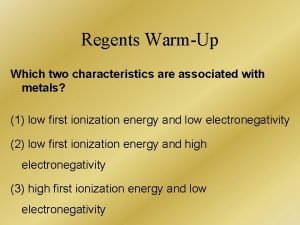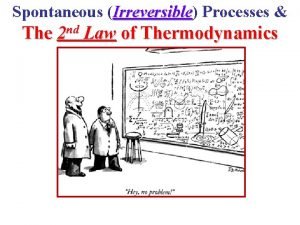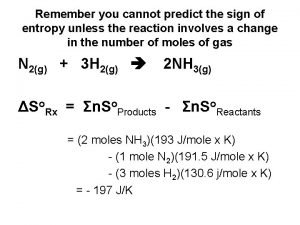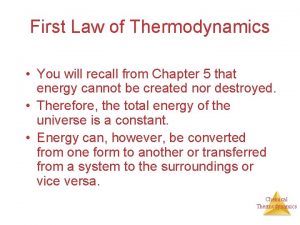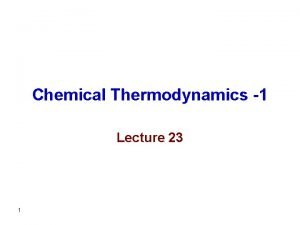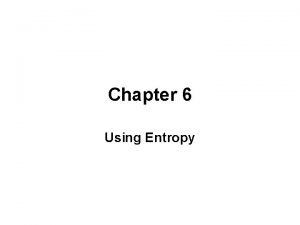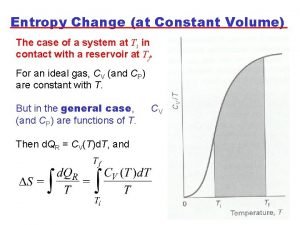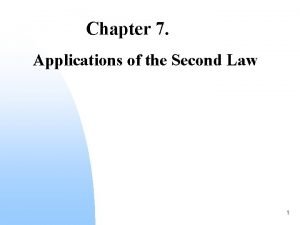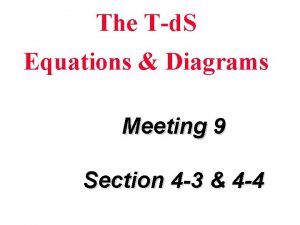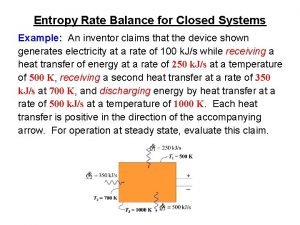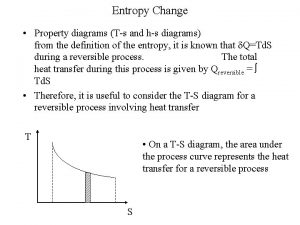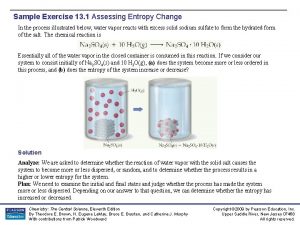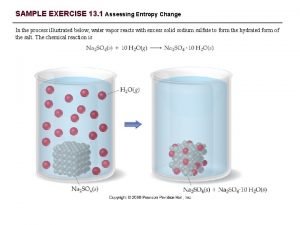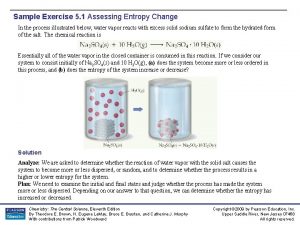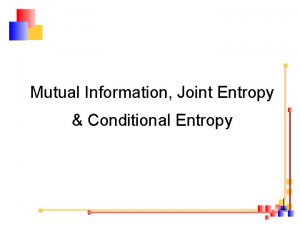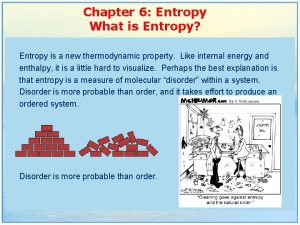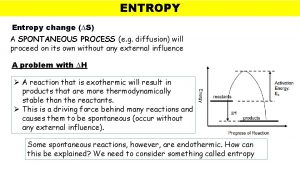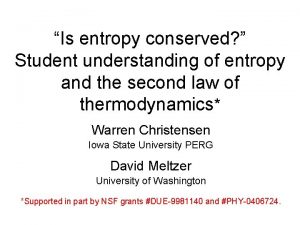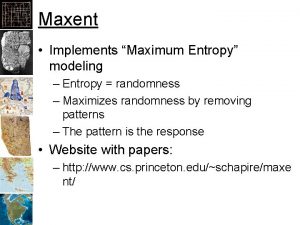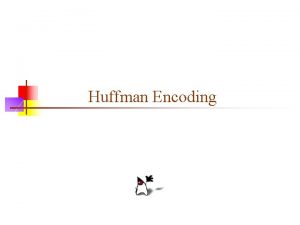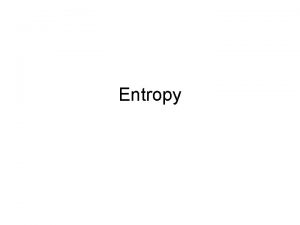Sample Exercise 5 1 Assessing Entropy Change In














- Slides: 14

Sample Exercise 5. 1 Assessing Entropy Change In the process illustrated below, water vapor reacts with excess solid sodium sulfate to form the hydrated form of the salt. The chemical reaction is Essentially all of the water vapor in the closed container is consumed in this reaction. If we consider our system to consist initially of Na 2 SO 4(s) and 10 H 2 O(g), (a) does the system become more or less ordered in this process, and (b) does the entropy of the system increase or decrease? Solution Analyze: We are asked to determine whether the reaction of water vapor with the solid salt causes the system to become more or less dispersed, or random, and to determine whether the process results in a higher or lower entropy for the system. Plan: We need to examine the initial and final states and judge whether the process has made the system more or less dispersed. Depending on our answer to that question, we can determine whether the entropy has increased or decreased. Chemistry: The Central Science, Eleventh Edition By Theodore E. Brown, H. Eugene Le. May, Bruce E. Bursten, and Catherine J. Murphy With contributions from Patrick Woodward Copyright © 2009 by Pearson Education, Inc. Upper Saddle River, New Jersey 07458 All rights reserved.

Sample Exercise 5. 1 Assessing Entropy Change Solution (continued) Solve: (a) In the course of forming the hydrate of Na 2 SO 4(s), the water vapor moves from the vapor state, in which it is dispersed throughout the entire volume of the container, to the solid state, where it is confined to the lattice. This means that the water vapor becomes less dispersed (more ordered, or less random). (b) When a system becomes less dispersed, or more ordered, its entropy is decreased. Practice Exercise Does the entropy of the system increase or decrease when the stopcock is opened to allow mixing of the two gases in this apparatus? Answer: The entropy increases because each gas eventually becomes dispersed in twice the volume it originally occupied. Chemistry: The Central Science, Eleventh Edition By Theodore E. Brown, H. Eugene Le. May, Bruce E. Bursten, and Catherine J. Murphy With contributions from Patrick Woodward Copyright © 2009 by Pearson Education, Inc. Upper Saddle River, New Jersey 07458 All rights reserved.

Sample Exercise 5. 2 A Henry’s Law Calculation Calculate the concentration of CO 2 in a soft drink that is bottled with a partial pressure of CO 2 of 4. 0 atm over the liquid at 25 °C. The Henry’s law constant for CO 2 in water at this temperature is 3. 1 × 10– 2 mol/L-atm. Solution Analyze: We are given the partial pressure of CO 2, , and the Henry’s law constant, k, and asked to calculate the concentration of CO 2 in the solution. Plan: With the information given, we can use Henry’s law, to calculate the solubility, C CO 2. Solve: CCO 2 = = (3. 1 × 10– 2 mol/L-atm)(4. 0 atm) = 0. 12 mol/L = 0. 12 M Check: The units are correct for solubility, and the answer has two significant figures consistent with both the partial pressure of CO 2 and the value of Henry’s constant. Practice Exercise Calculate the concentration of CO 2 in a soft drink after the bottle is opened and equilibrates at 25 °C under a CO 2 partial pressure of 3. 0 × 10– 4 atm. Answer: 9. 3 × 10– 6 M Chemistry: The Central Science, Eleventh Edition By Theodore E. Brown, H. Eugene Le. May, Bruce E. Bursten, and Catherine J. Murphy With contributions from Patrick Woodward Copyright © 2009 by Pearson Education, Inc. Upper Saddle River, New Jersey 07458 All rights reserved.

Sample Exercise 5. 3 Calculation of Vapor-Pressure Lowering Glycerin (C 3 H 8 O 3) is a nonvolatile nonelectrolyte with a density of 1. 26 g/m. L at 25 °C. Calculate the vapor pressure at 25 °C of a solution made by adding 50. 0 m. L of glycerin to 500. 0 m. L of water. The vapor pressure of pure water at 25 °C is 23. 8 torr (Appendix B), and its density is 1. 00 g/m. L. Solution Analyze: Our goal is to calculate the vapor pressure of a solution, given the volumes of solute and solvent and the density of the solute. Plan: We can use Raoult’s law (Equation 13. 10) to calculate the vapor pressure of a solution. The mole fraction of the solvent in the solution, XA, is the ratio of the number of moles of solvent (H 2 O) to total moles of solution (moles C 3 H 8 O 3 + moles H 2 O). Solve: To calculate the mole fraction of water in the solution, we must determine the number of moles of C 3 H 8 O 3 and H 2 O: We now use Raoult’s law to calculate the vapor pressure of water for the solution: The vapor pressure of the solution has been lowered by 0. 6 torr relative to that of pure water. Chemistry: The Central Science, Eleventh Edition By Theodore E. Brown, H. Eugene Le. May, Bruce E. Bursten, and Catherine J. Murphy With contributions from Patrick Woodward Copyright © 2009 by Pearson Education, Inc. Upper Saddle River, New Jersey 07458 All rights reserved.

Sample Exercise 5. 3 Calculation of Vapor-Pressure Lowering Practice Exercise The vapor pressure of pure water at 110 °C is 1070 torr. A solution of ethylene glycol and water has a vapor pressure of 1. 00 atm at 110 °C. Assuming that Raoult’s law is obeyed, what is the mole fraction of ethylene glycol in the solution? Answer: 0. 290 Chemistry: The Central Science, Eleventh Edition By Theodore E. Brown, H. Eugene Le. May, Bruce E. Bursten, and Catherine J. Murphy With contributions from Patrick Woodward Copyright © 2009 by Pearson Education, Inc. Upper Saddle River, New Jersey 07458 All rights reserved.

Sample Exercise 5. 4 Calculation of Boiling-Point Elevation and Freezing-Point Lowering Automotive antifreeze consists of ethylene glycol, CH 2(OH), a nonvolatile nonelectrolyte. Calculate the boiling point and freezing point of a 25. 0 mass % solution of ethylene glycol in water. Solution Analyze: We are given that a solution contains 25. 0 mass % of a nonvolatile, nonelectrolyte solute and asked to calculate the boiling and freezing points of the solution. To do this, we need to calculate the boiling -point elevation and freezing-point depression. Plan: To calculate the boiling-point elevation and the freezing-point depression using Equations 13. 11 and 12, we must express the concentration of the solution as molality. Let’s assume for convenience that we have 1000 g of solution. Because the solution is 25. 0 mass % ethylene glycol, the masses of ethylene glycol and water in the solution are 250 and 750 g, respectively. Using these quantities, we can calculate the molality of the solution, which we use with the molal boiling-point-elevation and freezing-point depression constants (Table 13. 4) to calculate ΔTb and ΔTf. We add ΔTb to the boiling point and subtract ΔTf from the freezing point of the solvent to obtain the boiling point and freezing point of the solution. Solve: The molality of the solution is calculated as follows: We can now use Equations 13. 11 and 13. 12 to calculate the changes in the boiling and freezing points: Chemistry: The Central Science, Eleventh Edition By Theodore E. Brown, H. Eugene Le. May, Bruce E. Bursten, and Catherine J. Murphy With contributions from Patrick Woodward Copyright © 2009 by Pearson Education, Inc. Upper Saddle River, New Jersey 07458 All rights reserved.

Sample Exercise 5. 4 Calculation of Boiling-Point Elevation and Freezing-Point Lowering Solution (continued) Hence, the boiling and freezing points of the solution are Comment: Notice that the solution is a liquid over a larger temperature range than the pure solvent. Practice Exercise Calculate the freezing point of a solution containing 0. 600 kg of CHCl 3 and 42. 0 g of eucalyptol (C 10 H 18 O), a fragrant substance found in the leaves of eucalyptus trees. (See Table 13. 4. ) Answer: – 65. 6 °C Chemistry: The Central Science, Eleventh Edition By Theodore E. Brown, H. Eugene Le. May, Bruce E. Bursten, and Catherine J. Murphy With contributions from Patrick Woodward Copyright © 2009 by Pearson Education, Inc. Upper Saddle River, New Jersey 07458 All rights reserved.

Sample Exercise 5. 5 Freezing-Point Depression in Aqueous Solutions List the following aqueous solutions in order of their expected freezing point: 0. 050 m Ca. Cl 2, 0. 15 m Na. Cl, 0. 10 m HCl, 0. 050 m CH 3 COOH, 0. 10 m C 12 H 22 O 11. Solution Analyze: We must order five aqueous solutions according to expected freezing points, based on molalities and the solute formulas. Plan: The lowest freezing point will correspond to the solution with the greatest concentration of solute particles. To determine the total concentration of solute particles in each case, we must determine whether the substance is a nonelectrolyte or an electrolyte and consider the number of ions formed when an electrolyte ionizes. Solve: Ca. Cl 2, Na. Cl, and HCl are strong electrolytes, CH 3 COOH (acetic acid) is a weak electrolyte, and C 12 H 22 O 11 is a nonelectrolyte. The molality of each solution in total particles is as follows: Because the freezing points depend on the total molality of particles in solution, the expected ordering is 0. 15 m Na. Cl (lowest freezing point), 0. 10 m HCl, 0. 050 m Ca. Cl 2, 0. 10 m C 12 H 22 O 11, and 0. 050 m CH 3 COOH (highest freezing point). Chemistry: The Central Science, Eleventh Edition By Theodore E. Brown, H. Eugene Le. May, Bruce E. Bursten, and Catherine J. Murphy With contributions from Patrick Woodward Copyright © 2009 by Pearson Education, Inc. Upper Saddle River, New Jersey 07458 All rights reserved.

Sample Exercise 5. 5 Freezing-Point Depression in Aqueous Solutions Practice Exercise Which of the following solutes will produce the largest increase in boiling point upon addition to 1 kg of water: 1 mol of Co(NO 3)2, 2 mol of KCl, 3 mol of ethylene glycol (C 2 H 6 O 2)? Answer: 2 mol of KCl because it contains the highest concentration of particles, 2 m K+ and 2 m Cl–, giving 4 m in all Chemistry: The Central Science, Eleventh Edition By Theodore E. Brown, H. Eugene Le. May, Bruce E. Bursten, and Catherine J. Murphy With contributions from Patrick Woodward Copyright © 2009 by Pearson Education, Inc. Upper Saddle River, New Jersey 07458 All rights reserved.

Sample Exercise 5. 6 Calculations Involving Osmotic Pressure The average osmotic pressure of blood is 7. 7 atm at 25 °C. What molarity of glucose (C 6 H 12 O 6) will be isotonic with blood? Solution Analyze: We are asked to calculate the concentration of glucose in water that would be isotonic with blood, given that the osmotic pressure of blood at 25 °C is 7. 7 atm. Plan: Because we are given the osmotic pressure and temperature, we can solve for the concentration, using Equation 13. Solve: Comment: In clinical situations the concentrations of solutions are generally expressed as mass percentages. The mass percentage of a 0. 31 M solution of glucose is 5. 3%. The concentration of Na. Cl that is isotonic with blood is 0. 16 M, because Na. Cl ionizes to form two particles, Na+ and Cl– (a 0. 155 M solution of Na. Cl is 0. 310 M in particles). A 0. 16 M solution of Na. Cl is 0. 9 mass % in Na. Cl. This kind of solution is known as a physiological saline solution. Practice Exercise What is the osmotic pressure at 20 °C of a 0. 0020 M sucrose (C 12 H 22 O 11) solution? Answer: 0. 048 atm, or 37 torr Chemistry: The Central Science, Eleventh Edition By Theodore E. Brown, H. Eugene Le. May, Bruce E. Bursten, and Catherine J. Murphy With contributions from Patrick Woodward Copyright © 2009 by Pearson Education, Inc. Upper Saddle River, New Jersey 07458 All rights reserved.

Sample Exercise 5. 7 Molar Mass for Freezing-Point Depression A solution of an unknown nonvolatile nonelectrolyte was prepared by dissolving 0. 250 g of the substance in 40. 0 g of CCl 4. The boiling point of the resultant solution was 0. 357 °C higher than that of the pure solvent. Calculate the molar mass of the solute. Solution Analyze: Our goal is to calculate the molar mass of a solute based on knowledge of the boiling-point elevation of its solution in CCl 4, ΔTb = 0. 357 °C, and the masses of solute and solvent. Table 13. 4 gives Kb for the solvent (CCl 4), Kb = 5. 02 °C/m. Plan: We can use Equation 13. 11, ΔTb = Kbm, to calculate the molality of the solution. Then we can use molality and the quantity of solvent (40. 0 g CCl 4) to calculate the number of moles of solute. Finally, the molar mass of the solute equals the number of grams per mole, so we divide the number of grams of solute (0. 250 g) by the number of moles we have just calculated. Solve: From Equation 13. 11 we have Thus, the solution contains 0. 0711 mol of solute per kilogram of solvent. The solution was prepared using 40. 0 g = 0. 0400 kg of solvent (CCl 4). The number of moles of solute in the solution is therefore The molar mass of the solute is the number of grams per mole of the substance: Chemistry: The Central Science, Eleventh Edition By Theodore E. Brown, H. Eugene Le. May, Bruce E. Bursten, and Catherine J. Murphy With contributions from Patrick Woodward Copyright © 2009 by Pearson Education, Inc. Upper Saddle River, New Jersey 07458 All rights reserved.

Sample Exercise 5. 7 Molar Mass for Freezing-Point Depression Practice Exercise Camphor (C 10 H 16 O) melts at 179. 8 °C, and it has a particularly large freezing-point-depression constant, Kf = 40. 0 °C/m. When 0. 186 g of an organic substance of unknown molar mass is dissolved in 22. 01 g of liquid camphor, the freezing point of the mixture is found to be 176. 7 °C. What is the molar mass of the solute? Answer: 110 g/mol Chemistry: The Central Science, Eleventh Edition By Theodore E. Brown, H. Eugene Le. May, Bruce E. Bursten, and Catherine J. Murphy With contributions from Patrick Woodward Copyright © 2009 by Pearson Education, Inc. Upper Saddle River, New Jersey 07458 All rights reserved.

Sample Exercise 5. 8 Molar Mass from Osmotic Pressure The osmotic pressure of an aqueous solution of a certain protein was measured to determine the protein’s molar mass. The solution contained 3. 50 mg of protein dissolved in sufficient water to form 5. 00 m. L of solution. The osmotic pressure of the solution at 25 °C was found to be 1. 54 torr. Treating the protein as a nonelectrolyte, calculate its molar mass. Solution Analyze: Our goal is to calculate the molar mass of a high-molecular-mass protein, based on its osmotic pressure and a knowledge of the mass of protein and solution volume. Plan: The temperature (T = 25 °C) and osmotic pressure ( =1. 54 torr) are given, and we know the value of R so we can use Equation 13. 13 to calculate the molarity of the solution, M. In doing so, we must convert temperature from °C to K and the osmotic pressure from torr to atm. We then use the molarity and the volume of the solution (5. 00 m. L) to determine the number of moles of solute. Finally, we obtain the molar mass by dividing the mass of the solute (3. 50 mg) by the number of moles of solute. Solve: Solving Equation 13. 13 for molarity gives Because the volume of the solution is 5. 00 ml = 5. 00 × 10– 3 L, the number of moles of protein must be Chemistry: The Central Science, Eleventh Edition By Theodore E. Brown, H. Eugene Le. May, Bruce E. Bursten, and Catherine J. Murphy With contributions from Patrick Woodward Copyright © 2009 by Pearson Education, Inc. Upper Saddle River, New Jersey 07458 All rights reserved.

Sample Exercise 5. 8 Molar Mass from Osmotic Pressure Solution (continued) The molar mass is the number of grams per mole of the substance. The sample has a mass of 3. 50 mg = 3. 50 × 10– 3 g. The molar mass is the number of grams divided by the number of moles: Comment: Because small pressures can be measured easily and accurately, osmotic pressure measurements provide a useful way to determine the molar masses of large molecules. Practice Exercise A sample of 2. 05 g of polystyrene of uniform polymer chain length was dissolved in enough toluene to form 0. 100 L of solution. The osmotic pressure of this solution was found to be 1. 21 k. Pa at 25 °C. Calculate the molar mass of the polystyrene. Answer: 4. 20 × 104 g/mol. Chemistry: The Central Science, Eleventh Edition By Theodore E. Brown, H. Eugene Le. May, Bruce E. Bursten, and Catherine J. Murphy With contributions from Patrick Woodward Copyright © 2009 by Pearson Education, Inc. Upper Saddle River, New Jersey 07458 All rights reserved.
 Assessing motivation to change
Assessing motivation to change Which sample has the greatest entropy
Which sample has the greatest entropy Non spontaneous process
Non spontaneous process Specific entropy equation
Specific entropy equation δhsys
δhsys Change in entropy formula
Change in entropy formula Entropy of the universe
Entropy of the universe Hrxn formula
Hrxn formula Units of entropu
Units of entropu Entropy change at constant volume
Entropy change at constant volume Adiabatic irreversible
Adiabatic irreversible Entropy change for incompressible substance
Entropy change for incompressible substance Entropy balance equation for closed systems
Entropy balance equation for closed systems H-s diagram
H-s diagram Change the sentence into indirect speech
Change the sentence into indirect speech

